 Trail of the Ancients Trail of the AncientsNational Scenic Byways | |
|---|---|
| Route information | |
| Length | 1,271 mi (2,045 km) |
| Location | |
| Country | United States |
| States | Arizona, Colorado, New Mexico, and Utah |
| Counties | Apache County, Arizona Navajo County, Arizona Montezuma County, Colorado McKinley County, New Mexico San Juan County, New Mexico San Juan County, Utah Cibola County, New Mexico |
| Highway system | |
| |
| |
| |
| |
The Trail of the Ancients is a collection of National Scenic Byways located in the U.S. Four Corners states of Utah, Colorado, New Mexico, and Arizona. These byways comprise:
- The 366-mile (589 km) Trail of the Ancients National Scenic Byway in San Juan County, Utah;
- The 116-mile (187 km) Trail of the Ancients Scenic and Historic Byway in Montezuma County, Colorado;
- The 662.4-mile (1,066 km) Trail of the Ancients Scenic Byway in McKinley and San Juan counties, New Mexico;
- The 100.3-mile (161 km) Dine' Tah "Among the People" Scenic Road in Apache County, Arizona, and the 26-mile (42 km) Kayenta-Monument Valley Scenic Road in Navajo County, Arizona.
The byways highlight the archaeological and cultural history of southwestern Native American peoples, and traverses the widely diverse geological landscape of the Four Corners region of the Colorado Plateau. It was the first National Scenic Byway that was designated primarily for its archaeological sites.
Route Description
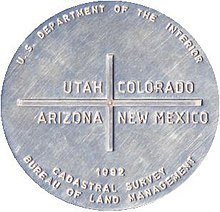
The National Scenic Byway connects prehistoric sites of Native Americans, including the Navajo, Utes and early puebloan people, who lived and farmed in the Four Corners area from about 1 CE to about 1300 CE. There were people hunting and gathering for food in the Four Corners region by 10,000 B.C. or earlier. Geological features include sandstone-rimmed canyons, snow-capped mountains, red rock landscapes and green valleys. Most of the stops — archaeological sites, Native American lands or modern communities — are near or on paved roads, but some of the roads are rugged graded roads.
Colorado
Four Corners to Mesa Verde
Four Corners Monument recognizes the only quadripoint in the United States. Members of the Navajo Nation (Utah, Arizona, and New Mexico), and the Ute Mountain Indian Reservation (Colorado) live in the Four Corners region on land surrounding the monument.
From the monument, the byway follows U.S. Route 160, crossing the San Juan River and continuing in a northeasterly direction, merging with U.S. Route 491 near the Ute Mountain Ute Tribal Park Visitor Center. The park has archaeological evidence of Ancestral Puebloan sites and the Ute culture. The route turns northerly, passing Ute Mountain and Yucca House National Monument, an unexcavated Ancestral Puebloan site.
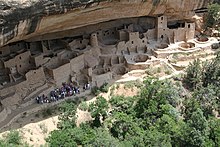
The route continues along U.S. Routes 160 / 491 to Cortez, the county seat of Montezuma County. Located within the city are the Cortez Cultural Center and Hawkins Preserve and Hawkins Pueblo. The Cortez Cultural Center has interpretive exhibits of the Navajo and Ute Native Americans and the early Puebloan people.
A spur of the byway follows Main Street / U.S. 160 east from Cortez to the entrance of Mesa Verde National Park, a U.S. national park preserving over 4000 archaeological sites - including 600 cliff dwellings - of the Ancestral Pueblo people. Mesa Verde is designated as a World Heritage Site.
Cortez to Hovenweep

The Colorado section of the byway continues north and west on state highways 145 and 184 from Cortez, passing Dolores, the McPhee Reservoir, and the Canyons of the Ancients Visitor Center and Museum, a museum of the Ancient Pueblo (or Anasazi) and other Native cultures in the Four Corners region. Escalante and Dominguez Pueblos are located on the center's site. The museum is also the location of the Canyons of the Ancients National Monument visitor center.
The byway briefly follows U.S. 491 through the unincorporated communities of Lewis, Yellow Jacket, and Pleasant View, before entering Canyons of the Ancients National Monument proper, a Bureau of Land Management site comprising over 6000 archaeological ruins over 183,000 acres., on Montezuma County Road CC.

Along the byway is Lowry Pueblo, a National Historic Landmark in Canyons of the Ancients National Monument, originally excavated in the 1930s and dating to around 1060 AD. The byway continues towards the Utah border along Montezuma County Road 10, crossing the Old Spanish National Historic Trail, a historic trade route connecting Santa Fe with Los Angeles.
At the Utah state line, the byway becomes San Juan County Road 213 (Hovenweep Road), passing some of the outlying sites of Hovenweep National Monument Hovenweep National Monument preserves six sites Ancestral Puebloan settlements in Utah and Colorado.
Utah
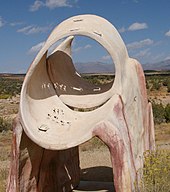
The Utah portion of the byway follows a patchwork of federal (U.S. Route 163, U.S. Route 191), state (Utah State Route 95, Utah State Route 261, Utah State Route 262), and local roads in San Juan County and northern Navajo Nation.
Hovenweep to Bluff and Blanding
After crossing the state border into Utah and passing the entrance to Hovenweep National Monument, the byway heads west to White Mesa and the junction with U.S. Route 191. South of White Mesa, the byway connects to Bluff and the southwestern sections of the byway; north of White Mesa, the route connects to Blanding and Edge of the Cedars State Park. The park features Ancestral Puebloan ruins, a museum, and artifacts that provide a detailed view of how the Ancestral Puebloan lived and worked.
The northernmost spur of the byway extends to Monticello, Utah. Nearby features include Manti–La Sal National Forest and Newspaper Rock State Historic Monument, one of the largest known collection of petroglyphs from indigenous peoples who lived in the area 2,000 years ago.
Blanding to Natural Bridges
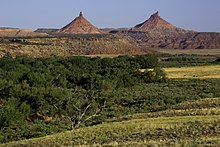
West of Blanding, the byway follows U.S. Route 95 across Comb Ridge and through Comb Wash, before ascending the eastern side of Cedar Mesa and entering Bears Ears National Monument.
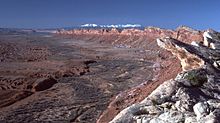
The monument is co-managed by the Bureau of Land Management and United States Forest Service, along with a coalition of five local Native American tribes: the Navajo Nation, Hopi, Ute Mountain Ute, Ute Indian Tribe of the Uintah and Ouray Reservation, and the Pueblo of Zuni, all of which have ancestral ties to the region. Nearby ruins include the partially reconstructed Mule Canyon Ruin and the Butler Wash cliff dwellings.
A short spur of the byway connects to Natural Bridges National Monument. The park loop passes three of the largest natural bridges in the world.
Natural Bridges to Monument Valley

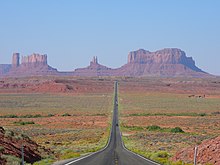
The byway heads south on Utah State Route 95 atop Cedar Mesa, passing the Grand Gulch Primitive Area and the eastern reaches of Glen Canyon National Recreation Area, before descending the plateau at Moki Dugway and entering the Valley of the Gods. A few miles through the valley is the turnoff for Goosenecks State Park, just outside the town of Mexican Hat.
The southwestern spur of the byway proceeds along U.S. 163 through Mexican Hat and crosses the San Juan River into Navajo Nation. This section of the byway ends at the Arizona border, within Monument Valley and at the entrance to Monument Valley Navajo Tribal Park.

Mexican Hat to Four Corners
The byway parallels the San Juan River east and north of Mexican Hat, once again crossing Comb Ridge and intersecting with U.S. 191 and Utah State Route 162 near Bluff. The byway continues through the San Juan valley , passing through Montezuma Creek, UT and Aneth, UT before reentering the Ute Mountain Ute Indian Reservation in Colorado and intersecting with U.S. 160 east of the Four Corners Monument.
Neighboring byways
Bicentennial Scenic Byway
The stretch of road from Blanding to Natural Bridges National Monument along Utah State Route 95 is also the Bicentennial Scenic Byway, which continues north on UT-95 to Hanksville, UT.
San Juan Skyway Scenic and Historic Byway
The Trail of the Ancients Scenic and Historic Byway overlaps with the San Juan Skyway Scenic and Historic Byway, an All-American Road, National Forest Scenic Byway, and Colorado Scenic and Historic Byway, on Colorado State Highway 145 between U.S. Highway 160 and Colorado State Highway 184.
History
The Trail of the Ancients was made a Utah state byway about 1990. The Trail of the Ancients Scenic and Historic Byway was designated a Colorado Scenic and Historic Byway in 1994. The Trail of the Ancients was designated a National Scenic Byway on September 22, 2005 by the U.S. Secretary of Transportation and the Federal Highway Administration. The designation was the first National Scenic Byway that totally focused its sites' archaeological qualities.
New Mexico and Arizona
Main article: Trail of the Ancients Scenic Byway (New Mexico)Arizona and New Mexico are applying to have the portions of the Trail of the Ancients in their states designated National Scenic Byways. This would include the Navajo National Monument and the Canyon de Chelly National Monument in Arizona, and Chaco Culture National Historical Park in New Mexico. When all four states have official national designations the Trail of the Ancients will acquire the highest status for roads, All-American Road.
The New Mexico Trail of the Ancients was made a New Mexico Scenic Byway after July 13, 1998 and by 2013.
See also
- List of Arizona Scenic Roads
- List of Colorado Scenic and Historic Byways
- List of New Mexico Scenic and Historic Byways
- List of Utah Scenic Byways
- Scenic byways in the United States
Notes
- At the intersection of State Road-41, the northwesterly road leads to the Utah section of the Trail of the Ancients
- Senate Bill 1414 was introduced on July 15, 2005 calling for a "study of the suitability and feasibility of establishing the Trail of the Ancients National Heritage Area in the Four Corners region of the States of Utah, Colorado, Arizona, and New Mexico." The Heritage Area was to include the Trail of Ancients Scenic Byway. It was not enacted.
References
- "Trail of the Ancients - Utah". America's Scenic Byways. Retrieved March 31, 2022.
- "Trail of The Ancients". Colorado Department of Transportation. 2021. Retrieved March 31, 2022.
- "Trail of the Ancients - Colorado". America's Scenic Byways. Retrieved March 31, 2022.
- "Trail of the Ancients - NM". America's Scenic Byways. Retrieved March 31, 2022.
- "Dine' Tah "Among the People" Scenic Road". America's Scenic Byways. Retrieved March 31, 2022.
- "Kayenta-Monument Valley Scenic Road". America's Scenic Byways. Retrieved March 31, 2022.
- ^ Trail of the Ancients brochure. Trail of the Ancients Byway Association. Retrieved August 13, 2014.
- Four Corners Monument. Utah Travel Industry. Retrieved August 13, 2014.
- "Cortez Cultural Center." Archived 2011-07-16 at the Wayback Machine Retrieved on 2010-07-09.
- "Mesa Verde National Park." National Park Service. Retrieved 2010-07-09.
- "Canyons of the Ancients: Background." Bureau of Land Management. Retrieved 2010-07-09.
- "Lowry Pueblo." Archived 2010-07-16 at the Wayback Machine Bureau of Land Management. Retrieved 2010-07-09.
- "Old Spanish Trail Association." Retrieved 2010-07-09.
- Hovenweep Visitor Guide, National Park Service. Retrieved August 13, 2014.
- "Edge of the Cedars State Park." Retrieved 2010-07-11.
- ^ Trail of the Ancients brochure. Trail of the Ancients Byway Association. p. 2 Retrieved August 13, 2014.
- "Newspaper Rock". Utah Travel Industry Website. Archived from the original on 2009-08-16. Retrieved 2020-11-24.
- Newspaper Rock State Historic Monument. Desert USA. Retrieved August 13, 2014.
- "Natural Bridges National Monument." Retrieved 2010-07-11.
- Trail of the Ancients map. Trail of the Ancients. Retrieved August 13, 2014.
- Neighboring Byways. Trail of the Ancients. Retrieved August 13, 2014.
- San Juan Skyway. Neighboring Byways. Trail of the Ancients. Retrieved August 13, 2014.
- Trail of the Ancients Corridor Management Plan Colorado Department of Transportation. 2009. Retrieved August 13, 2014.
- ^ Thomas Wharton. "Focus on archaeology a national system first" Salt Lake Times. December 25, 2005. Retrieved August 13, 2014.
- Trail of the Ancients. Scenic Byways. Colorado Department of Transportation. August 13, 2014.
- Trail of the Ancients Scenic Byway. Archived 2014-08-14 at the Wayback Machine Utah Travel Industry. October 4, 2005. Retrieved August 13, 2014.
- National Scenic Byways Program. U.S. Department of Transportation. Retrieved August 12, 2014.
- Senate bill 1414 - Trail of the Ancients National Heritage Act Study Act of 2005 - introduced July 15, 2005. GovTrak. Retrieved August 13, 2014.
- Congress (30 December 2009). Congressional Record, V. 151, Pt. 12, July 14 to July 22, 2005. Government Printing Office. p. 337. ISBN 9780160848032. GGKEY:EQ7ZDQLQWX8.
- 18 NMAC 31.2 New Mexico Scenic and Historic Byways Program. Transportation and Highways. New Mexico Legislation. Filed February 27, 1998. Effective July 31, 1998. Retrieved August 10, 2014.
- New Mexico Designated Unique or Valuable Scenic Landscapes. United States Department of Agriculture. Natural Resources Conservation Service. Issued in 2013. Retrieved August 11, 2014. Note: Not the best source as not an official list, but it wouldn't have made it onto the list if it wasn't a byway at that point
External links
- America's Byways
- America's Scenic Byways
- Arizona Department of Transportation
- Colorado Department of Transportation
- New Mexico Department of Transportation
- Utah Department of Transportation
| Protected areas of Arizona | |||||||||||||||||||||
|---|---|---|---|---|---|---|---|---|---|---|---|---|---|---|---|---|---|---|---|---|---|
| Federal |
| ||||||||||||||||||||
| State |
| ||||||||||||||||||||
| Municipal |
| ||||||||||||||||||||
| Other |
| ||||||||||||||||||||
| Protected areas of Colorado | |||||||||||||||||||||||||||||||||
|---|---|---|---|---|---|---|---|---|---|---|---|---|---|---|---|---|---|---|---|---|---|---|---|---|---|---|---|---|---|---|---|---|---|
| Federal |
| ||||||||||||||||||||||||||||||||
| State |
| ||||||||||||||||||||||||||||||||
| Trails |
| ||||||||||||||||||||||||||||||||
| Protected areas of New Mexico | |
|---|---|
| National Parks | |
| National Historical Parks | |
| National monuments | |
| National Recreation Areas | |
| National Trails | |
| National Forests | |
| National Grasslands | |
| National Wildlife Refuges | |
| National Conservation Areas | |
| BLM National Monuments | |
| National Natural Landmarks | |
| National Preserves | |
| Wilderness |
|
| Wild and Scenic Rivers | |
| State Parks |
|
| Protected areas of Utah | |||||||||||||||||||||||||
|---|---|---|---|---|---|---|---|---|---|---|---|---|---|---|---|---|---|---|---|---|---|---|---|---|---|
| Federal |
| ||||||||||||||||||||||||
| State |
| ||||||||||||||||||||||||
| Contemporary peoples native to Arizona | |
|---|---|
| Prehistoric cultures in Arizona | |
| See also: List of Indian reservations in Arizona | |
| Overview | |||||||||
|---|---|---|---|---|---|---|---|---|---|
| Contemporary peoples native to Colorado |
| ||||||||
| Precontact cultures in Colorado |
| ||||||||
| Related articles | |||||||||